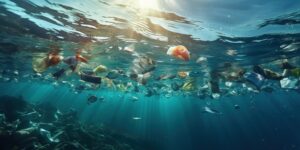Microplastics: A health hazard!
Plastics are considered durable materials for packaging and other viable uses. However, environmentalists time and again have warned about the repercussions of the use of plastic. Its non-durability is a boon, but it is also a bane in the limelight. A new form of threat is arising with the increasing production of plastics in the environment. It is directly entering into our body. This is known as microplastics.
What is microplastic? How is it entering our body? What will be its long-term consequences? How to avoid its consumption? This blog here shall deal with the fundamentals of microplastics and its relationship with you!
What are microplastics?

In a book named, “An Author of a Life”, it is stated that irrespective of the brand of water bottle, it contains 325 microplastic in it. Depending on the source of microplastic generation, they can be classified into two broad categories: –
-
Primary microplastic
These are the plastics that are directly released into nature from the source. For example: – Microbeads in facial scrubs.
-
Secondary microplastic
The breakdown of larger plastic materials into smaller particles through a variety of measures such as heat or UV rays
It is a surprising fact that toothbrushes that are made of Nylon do release microplastics. Except for these sources, agricultural practices, marine food, microplastic in the air, detergents, and lubricants are all sources through which it enters our bodies.
Effects of microplastics on health
Microplastics have wide-ranging ramifications on health. Although the matter is not very clear among the community of scientists. However, the non-degradable nature of this waste can inform us about the repercussions this can have on our bodies. Any particle that enters our body through our mouth tends to go to blood. Thus, it finally reaches the heart to get pumped. In this process of biomagnification when these particles reach the body, it can alter the basic decomposition mechanism of our body.
Researchers have calculated the amount of microplastics entering our body and have found that we are eating a credit card in a month! Once entered into our body, it will never degrade through biological processes. Consumption of plastics can thus have cancerous effects because of their non-degradable nature. Also, it can affect our digestive, reproductive and respiratory systems.
How to avoid microplastics in food
-
Avoid packed drinking water
Water that is being packed in plastic bottles tends to release microplastics in water. This is especially true in the present scenario where the average temperature ranges around 50 degrees Celsius. Thus, we must pursue some non-plastic containers for containing water. Many startups nowadays are making wooden bottles to reduce the use of plastic containers.
2. Remove the gut of seafood
As a result of human alteration, our ocean bodies are contaminated with microplastics. Thus, it is normal for marine animals to consume those plastics that indirectly reach our bodies. Researchers have proved the contamination of microplastic particles in the guts of fishes. Thus, we must not eat that part while consuming marine food
3. Organic vegetables.
Organically farmed vegetables are less susceptible to exposure to microplastics. Thus, making it a good choice to reduce the risks of microplastics
4. To restrict the Tajon horse effect: –
It is a scientific term referring to all mediums that are responsible for the transportation of microplastic from one place to another. If technologically anyhow this can be controlled, the process of biomagnification can be reduced.
5. Don’t use leakers for tea the
The usage of plastic cups and leakers for tea is responsible for the ample amount of microplastic consumption. Thus, we must use natural cups to have tea without using the leaker bags.
6. Never use plastic containers in the microwave
Microwaves produce a lot of heat and thus can be responsible for chemical reactions with plastics. Thus, it will definitely release the plastic particles in your food.
7. Limit the processed food.
We must limit the highly processed food. As such food items have a high vulnerability to plastic exposure thus inculcating microplastic within us.
Thus, in a nutshell, we can conclude that this process of biomagnification has catastrophic ramifications for our health. Thus, there is an urgent need that we must move towards environmentally friendly ways to deal with our issues. The major cause itself is increasing production of plastic which must be limited. Otherwise, the time it will rise as an epidemic is not so far!
References
MDPI Blogs, freepik images, missionsustainability.org
https://missionsustainability.org/blog/microplastic-a-macro-problem/




















